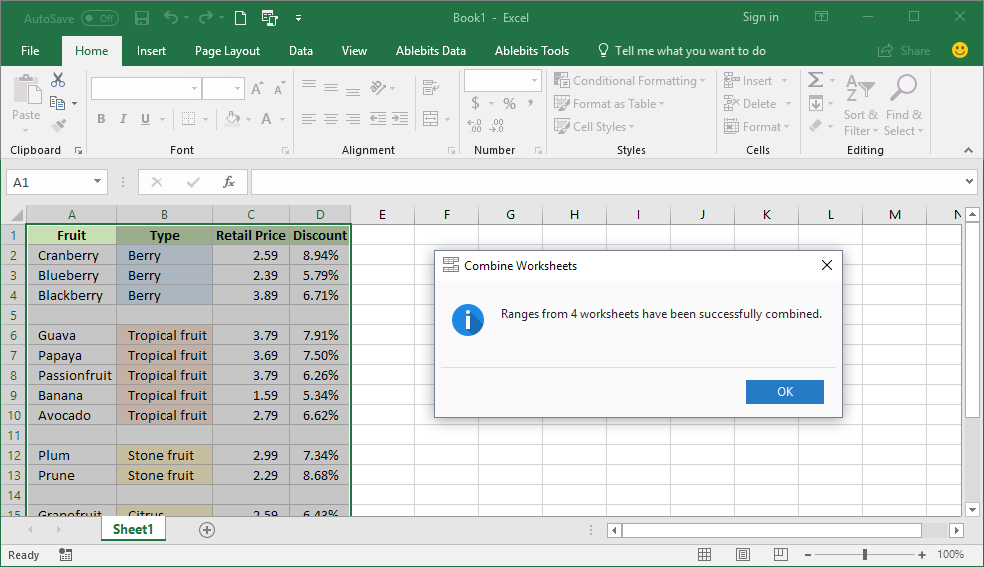5 Ways to Merge Excel Sheets Effectively

Merging Excel spreadsheets efficiently can be a daunting task, especially when managing large datasets or multiple files. Here, we'll explore five effective methods to streamline your data consolidation process, ensuring that you get the most accurate, swift, and error-free merging experience in Microsoft Excel. Whether you're a financial analyst, a data scientist, or just someone who juggles spreadsheets daily, these techniques will simplify your workflow.
Method 1: Using Excel's Consolidate Feature

Excel's Consolidate feature is perfect for merging data from multiple sheets into one. Here's how you can do it:
- Select the destination cell in the sheet where you want to consolidate data.
- Go to the Data tab and click on Consolidate.
- In the Function box, select the operation like 'Sum', 'Average', etc.
- Click Add to specify the range of data from each sheet. Repeat this for all sheets.
- Ensure the Top row and Left column are checked if your data has labels.
- Hit OK to see the merged data.
⚠️ Note: Excel's Consolidate function is great for summing up data but may not work well if you need to keep unique entries from each sheet.

Method 2: Utilizing Power Query

Power Query is a powerful tool for data transformation within Excel. To merge sheets using Power Query:
- Go to the Data tab and select From Other Sources > From Microsoft Query if you want to use external data.
- Choose Excel Files from the list and locate your workbooks.
- Select the tables or ranges you need to combine.
- Right-click, choose Merge or Append in the Home tab.
- Adjust the settings to align with your data needs, then click Close & Load to see the results in a new sheet.
Method 3: VBA Script for Advanced Merging

For those comfortable with coding, Visual Basic for Applications (VBA) can automate the merging process:
- Open the VBA editor by pressing Alt + F11.
- Insert a new module and write a script like:
Sub MergeSheets()
Dim ws As Worksheet
Dim wsNew As Worksheet
Dim lastRow As Long, lastCol As Long
Set wsNew = ThisWorkbook.Sheets.Add
wsNew.Name = "Merged Data"
For Each ws In ThisWorkbook.Sheets
If ws.Name <> "Merged Data" Then
lastRow = ws.Cells(ws.Rows.Count, 1).End(xlUp).Row
lastCol = ws.Cells(1, ws.Columns.Count).End(xlToLeft).Column
ws.Range(ws.Cells(1, 1), ws.Cells(lastRow, lastCol)).Copy wsNew.Range("A1")
With wsNew
lastRow = .Cells(.Rows.Count, 1).End(xlUp).Row
.Cells(lastRow + 1, 1).Value = "---" & ws.Name & "---"
End With
End If
Next ws
End Sub
💡 Note: VBA can automate repetitive tasks, but it requires basic programming knowledge. Always test your script on a small dataset first.
Method 4: Using External Software

Sometimes, Excel's in-built features are not enough. Here are some external tools that can help:
| Tool Name | Features | Cost |
|---|---|---|
| Merge Excel Files | Batch processing, scheduled merging | $49 (one-time purchase) |
| PowerTools | Automated merge, real-time updates | $99/year |
| Data Merger | Excel, CSV, SQL support | Free (limited features), Pro from $69 |

These tools can provide a more robust merging experience but might come at a cost or require some setup time.
Method 5: Manual Cut and Paste

When dealing with small datasets, sometimes the simplest method is the most effective:
- Open each Excel sheet or workbook.
- Copy the relevant data or entire range from one sheet.
- Paste it into the destination sheet, ensuring data integrity and consistency in formatting.
📝 Note: Manual methods are prone to human error. Always double-check your data before finalizing any merge.
Effective merging of Excel sheets is essential for accurate data analysis, reporting, and streamlining business processes. From Excel's built-in features like Consolidate and Power Query, to the use of VBA for automation, and external tools for large datasets, you now have an array of techniques to choose from based on your specific needs. Each method has its advantages and potential limitations, so understanding when and how to apply each one is key. By mastering these methods, you'll be equipped to manage your data more effectively, saving time and reducing errors in your workflow.
Can I merge Excel sheets from different workbooks?

+
Yes, you can merge sheets from different workbooks using the Consolidate feature or Power Query. Ensure that all workbooks are accessible during the merge process.
What is the best method for merging if I need to keep unique entries?

+
For keeping unique entries, using Power Query or a VBA script that filters for unique entries would be most efficient.
Are there any risks when using external software for merging Excel sheets?

+
Yes, external software might introduce security risks, licensing issues, or compatibility problems with future Excel updates. Always choose reputable software with good user reviews.



